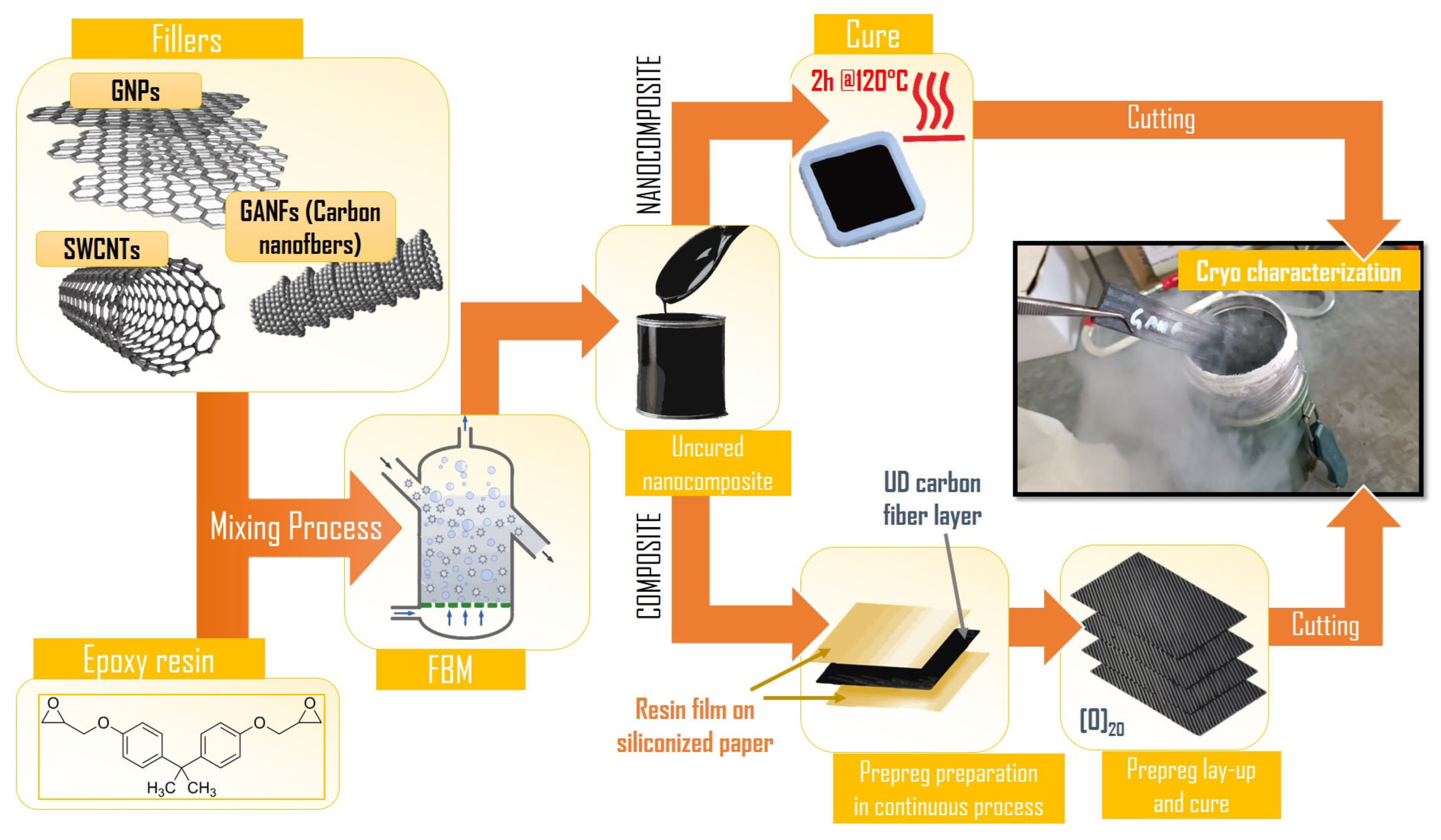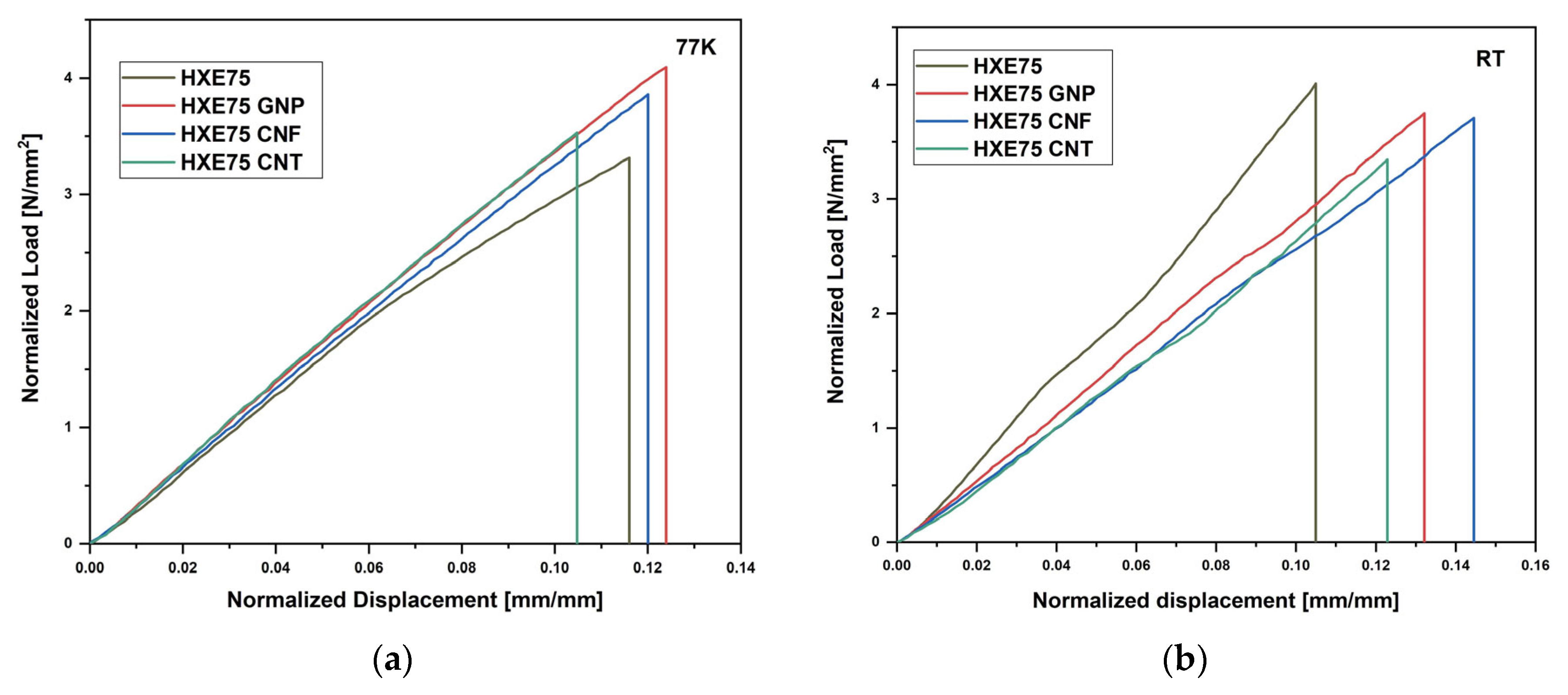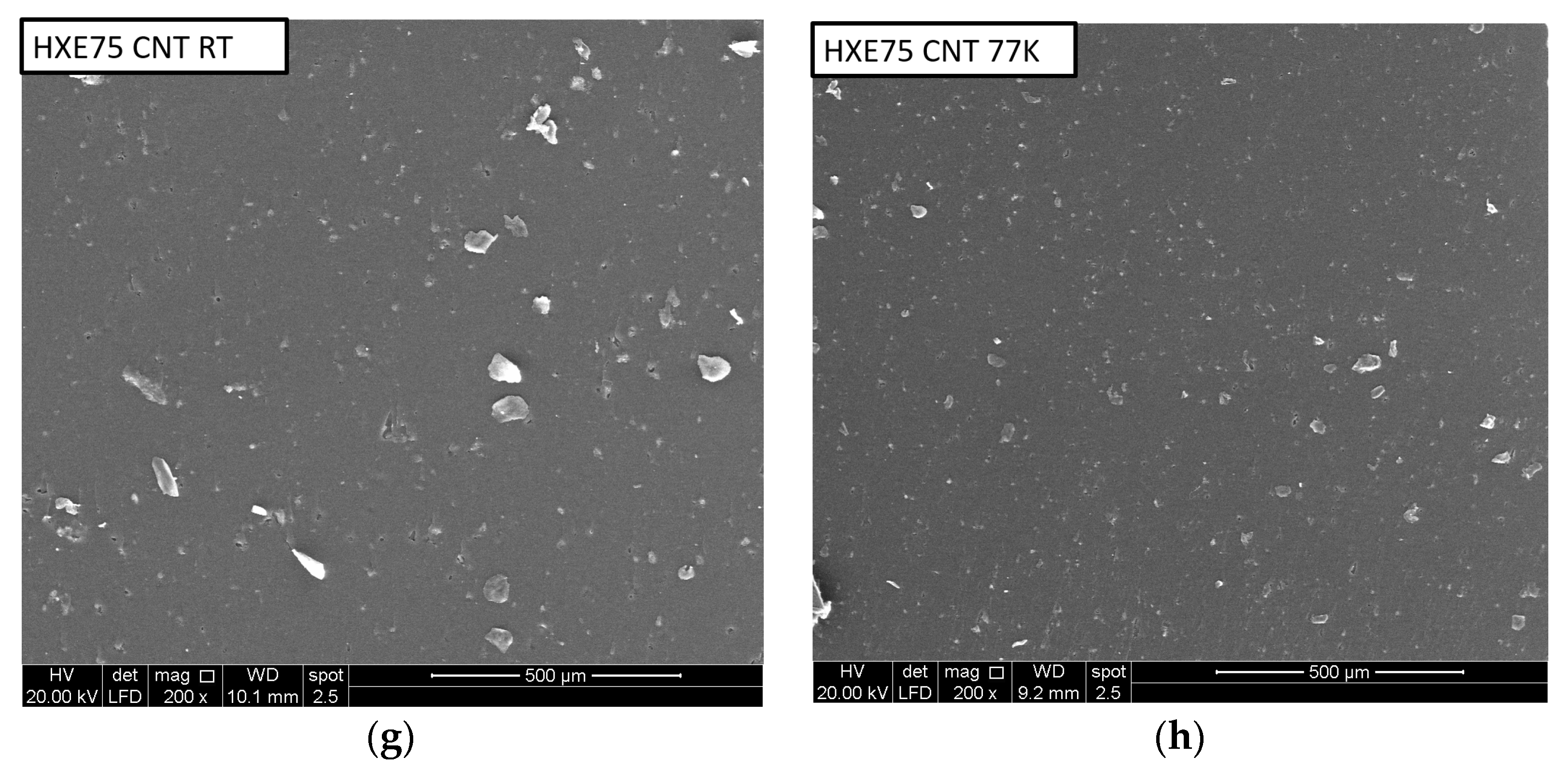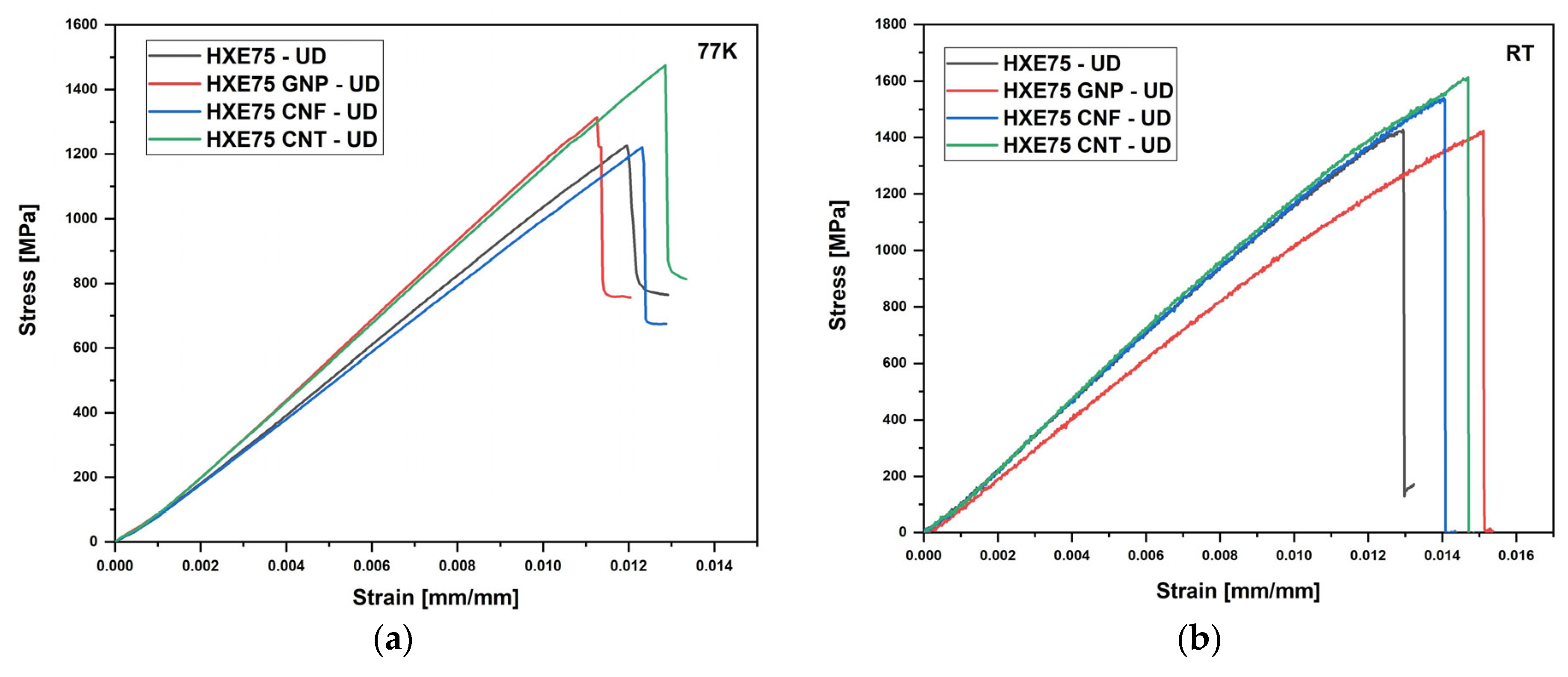The Effect of Carbon-Based Nanofillers on Cryogenic Temperature Mechanical Properties of CFRPs
Abstract
:1. Introduction
2. Materials and Methods
2.1. Materials
2.2. Nanocomposite and Composite Manufacturing
2.3. Experimental Characterization
3. Results
4. Conclusions
Author Contributions
Funding
Data Availability Statement
Conflicts of Interest
References
- Soutis, C. Carbon fiber reinforced plastics in aircraft construction. Mater. Sci. Eng. A 2005, 412, 171–176. [Google Scholar] [CrossRef]
- Elmahdy, A.; Zotti, A.; Zuppolini, S.; Zarrelli, M.; Borriello, A.; Verleysen, V. Effect of Strain Rate and Silica Filler Content on the Compressive Behavior of RTM6 Epoxy-Based Nanocomposites. Polymers 2021, 13, 3735. [Google Scholar] [CrossRef]
- Friedrich, K.; Almajid, A.A. Manufacturing aspects of advanced polymer composites for automotive applications. Appl. Compos. Mater. 2013, 20, 107–128. [Google Scholar] [CrossRef]
- Garcia-Espinel, J.D.; Castro-Fresno, D.; Gayo, P.P.; Ballester-Muñoz, F. Effects of sea water environment on glass fiber reinforced plastic materials used for marine civil engineering constructions. Mater. Des. 2015, 66, 46–50. [Google Scholar] [CrossRef]
- Qian, D. Fiber-reinforced polymer composite materials with high specific strength and excellent solid particle erosion resistance. Wear 2010, 268, 637–642. [Google Scholar] [CrossRef]
- Ning, Z.; Liu, R.; El Hajjar, R.F.; Wang, F. Micro-modeling of thermal properties in carbon fibers reinforced polymer composites with fiber breaks or delamination. Compos. Part B Eng. 2017, 114, 247–255. [Google Scholar] [CrossRef]
- Liu, L.; Jia, C.; He, J. Interfacial characterization, control and modification of carbon fiber reinforced polymer composites. Compos. Sci. Technol. 2015, 121, 56–72. [Google Scholar] [CrossRef]
- Zotti, A.; Borriello, A.; Ricciardi, M.; Antonucci, V.; Giordano, M.; Zarrelli, M. Effects of sepiolite clay on degradation and fire behaviour of a bisphenol A-based epoxy. Compos. Part B Eng. 2015, 73, 139–148. [Google Scholar] [CrossRef]
- Kaw, A.K. Mechanics of Composite Materials, 2nd ed.; CRC Press: Boca Raton, FL, USA, November 2005. [Google Scholar]
- Xian, G.; Guo, R.; Li, C. Combined effects of sustained bending loading, water immersion and fiber hybrid mode on the mechanical properties of carbon/glass fiber reinforced polymer composite. Compos. Struct. 2022, 281, 115060. [Google Scholar] [CrossRef]
- Timmerman, J.F.; Tillman, M.S.; Hayes, B.S.; Seferis, J.C. Matrix and fiber influences on the cryogenic microcracking of carbon fiber/epoxy composites. Compos. Part A Appl. Sci. Manuf. 2002, 33, 323–329. [Google Scholar] [CrossRef]
- Sápi, Z.; Butler, R. Properties of cryogenic and low temperature composite materials—A review. Cryogenics 2020, 111, 103190. [Google Scholar] [CrossRef]
- Hung, P.Y.; Lau, K.T.; Fox, B.; Hameed, N.; Jia, B.; Lee, J.H. Effect of graphene oxide concentration on the flexural properties of CFRP at low temperature. Carbon 2019, 152, 556–564. [Google Scholar] [CrossRef]
- Yang, L.; Li, Z.; Xu, H.; Wu, Z. Prediction on Residual Stresses of Carbon/Epoxy Composite at Cryogenic Temperature. Polym. Compos. 2019, 40, 3369–3786. [Google Scholar] [CrossRef]
- Ward, I.M.; Sweeney, J. Mechanical Properties of Solid Polymers, 3rd ed.; John Wiley & Sons, Ltd.: Hoboken, NJ, USA, 2013. [Google Scholar]
- Zhao, Y.; Chen, Z.K.; Liu, Y.; Xiao, H.M.; Feng, Q.P.; Fu, S.Y. Simultaneously enhanced cryogenic tensile strength and fracture toughness of epoxy resins by carboxylic nitrile-butadiene nano-rubber. Compos. Part A Appl. Sci. Manuf. 2013, 55, 178–187. [Google Scholar] [CrossRef]
- Zhang, Y.; Xu, F.; Zhang, C.; Wang, J.; Jia, Z.; Hui, D. Tensile and interfacial properties of polyacrylonitrile-based carbon fiber after different cryogenic treated condition. Compos. Part B Eng. 2016, 99, 358–365. [Google Scholar] [CrossRef]
- Shi, H.Q.; Sun, B.G.; Liu, Q.; Yang, Z.Y.; Zhang, Y. Properties of cryogenic Epoxy Resin Matrix Composites prepared by RTM Process. In Proceedings of the 20th International Conference on Composite Materials, Copenhagen, Denmark, 19–24 July 2015. [Google Scholar]
- Qu, C.B.; Huang, Y.; Li, F. Enhanced cryogenic mechanical properties of carbon fiber reinforced epoxy composites by introducing graphene oxide. Compos. Commun. 2020, 22, 100480. [Google Scholar] [CrossRef]
- Zotti, A.; Zuppolini, S.; Borriello, A.; Trinchillo, L.; Vinti, V.; Zarrelli, M. Hierarchical aerospace epoxy composites of carbon fiber and hyperbranched filler: Toughening behavior from nanocomposites to composites. Compos. Struct. 2024, 327, 117719. [Google Scholar] [CrossRef]
- Zotti, A.; Zuppolini, S.; Borriello, A.; Zarrelli, M. Polymer nanocomposites based on Graphite Nanoplatelets and amphiphilic graphene platelets. Compos. Part B Eng. 2022, 246, 110223. [Google Scholar] [CrossRef]
- Chen, D.; Li, J.; Yuan, Y. A Review of the Polymer for Cryogenic Application: Methods, Mechanisms and Perspectives. Polymers 2021, 13, 320. [Google Scholar] [CrossRef]
- Chen, Z.K.; Yang, J.P.; Ni, Q.Q.; Fu, S.Y.; Huang, Y.G. Reinforcement of epoxy resins with multi-walled carbon nanotubes for enhancing cryogenic mechanical properties. Polymer 2009, 50, 4753–4759. [Google Scholar] [CrossRef]
- Hung, P.Y.; Lau, K.T.; Qiao, K.; Fox, B.; Hameed, N. Property enhancement of CFRP composites with different graphene oxide employment methods at a cryogenic temperature. Compos. Part A 2019, 120, 56–63. [Google Scholar] [CrossRef]
- Nobelen, M.; Hayes, B.S.; Seferis, J.C. Influence of elastomer distribution on the cryogenic microcracking of carbon fiber/epoxy composites. J. Appl. Polym. Sci. 2003, 90, 2268–2275. [Google Scholar] [CrossRef]
- Di Cosmo, A.; D’andrea, B.; Vinti, V. Polymeric Formulations with Chemically Adjustable Rheology for the Manufacture of Prepregs and Articles Made of Composite Material. U.S. Patent 9217082B2, 22 December 2015. [Google Scholar]
- Zotti, A.; Zuppolini, S.; Borriello, A.; Vinti, V.; Trinchillo, L.; Borrelli, D.; Caraviello, A.; Zarrelli, M. Effect of the Mixing Technique of Graphene Nanoplatelets and Graphene Nanofibers on Fracture Toughness of Epoxy Based Nanocomposites and Composites. Polymers 2022, 14, 5105. [Google Scholar] [CrossRef] [PubMed]
- Ma, H.I.; Jia, Z.; Lau, K.; Leng, J.; Hui, D. Impact properties of glass fiber/epoxy composites at cryogenic environment. Compos. Part B 2016, 92, 210–217. [Google Scholar] [CrossRef]
- ASTM D5045; Standard Test Methods for Plane-Strain Fracture Toughness and Strain Energy Release Rate of Plastic Materials. ASTM International: West Conshohocken, PA, USA, 2022.
- ASTM D2344; Standard Test Method for Short-Beam Strength of Polymer Matrix Composite Materials and Their Laminates. ASTM International: West Conshohocken, PA, USA,, 2022.
- ASTM D790; Standard Test Methods for Flexural Properties of Unreinforced and Reinforced Plastics and Electrical Insulating Materials. ASTM International: West Conshohocken, PA, USA, 2017.
- Schulz, S.C.; Faiella, G.; Buschhorn, S.T.; Prado, L.A.S.A.; Giordano, M.; Schulte, K.; Bauhofer, W. Combined electrical and rheological properties of shear induced multiwall carbon nanotube agglomerates in epoxy suspensions. Eur. Polym. J. 2011, 47, 2069–2077. [Google Scholar] [CrossRef]
- Nishijima, S.; Honda, Y.; Okada, T. Application of the positron annihilation method for evaluation of organic materials for cryogenic use. Cryogenics 1995, 35, 779–781. [Google Scholar] [CrossRef]
- Zotti, A.; Zuppolini, S.; Zarrelli, M.; Borriello, A. Fracture toughening mechanisms in epoxy adhesives. In Adhesives-Applications and Properties; InTech: London, UK, 2016; Volume 1, p. 257. [Google Scholar]
- Zotti, A.; Zuppolini, S.; Tábi, T.; Grasso, M.; Ren, G.; Borriello, A.; Zarrelli, M. Effects of 1D and 2D nanofillers in basalt/poly (lactic acid) composites for additive manufacturing. Compos. Part B Eng. 2016, 153, 364–375. [Google Scholar] [CrossRef]
- Islam, M.S.; Melendez-Soto, E.; Castellanos, A.G.; Prabhakar, P. Investigation of Woven Composites as Potential Cryogenic Tank Materials. Cryogenics 2015, 72, 82–89. [Google Scholar] [CrossRef]
- Sethi, S.; Rathore, D.K.; Ray, B.C. Effects of temperature and loading speed on interface-dominated strength in fibre/polymer composites: An evaluation for in-situ environment. Mater. Des. 2015, 65, 617–625. [Google Scholar] [CrossRef]
- Takeda, T.; Shindo, Y.; Fukuzaki, T.; Narita, F. Short beam interlaminar shear behaviour and electrical resistance-based damage self-sensing of woven carbon/epoxy composite laminates in a cryogenic environment. J. Compos. Mater. 2014, 48, 119–128. [Google Scholar] [CrossRef]
- Kumar, M.S.; Sharma, N.; Ray, B.C. Microstructural and Mechanical Aspects of Carbon/Epoxy Composites at Liquid Nitrogen Temperature. J. Reinf. Plast. Compos. 2009, 28, 2013–2023. [Google Scholar] [CrossRef]
- Shukla, M.J.; Kumar, D.S.; Mahato, K.K.; Rathore, D.K.; Prusty, R.K.; Ray, B.C. A comparative study of the mechanical performance of Glass and Glass/Carbon hybrid polymer composites at different temperature environments. IOP Conf. Ser. Mater. Sci. Eng. 2015, 75, 012002. [Google Scholar]










| Sample ID | Filler Typology | Filler Content [wt%] | Carbon Fiber Reinforcement |
|---|---|---|---|
| HXE75 | - | 0 | - |
| HXE75 GNP | GNPs | 0.5 | - |
| HXE75 CNF | CNFs | 0.5 | - |
| HXE75 CNT | CNTs | 0.1 | - |
| HXE75-UD | - | 0 | T700 UD |
| HXE75 GNP-UD | GNPs | 0.5 | T700 UD |
| HXE75 CNF-UD | CNFs | 0.5 | T700 UD |
| HXE75 CNT-UD | CNTs | 0.1 | T700 UD |
| 77 K | RT | |||
|---|---|---|---|---|
| KIC [MPa m1/2] | ΔKIC [%] | KIC [MPa m1/2] | ΔKIC [%] | |
| HXE75 | 1.59 ± 0.08 | - | 1.56 ± 0.09 | - |
| HXE75 GNP | 1.80 ± 0.02 | 13.2 | 1.79 ± 0.04 | 14.7 |
| HXE75 CNF | 1.77 ± 0.06 | 11.3 | 1.74 ± 0.06 | 11.5 |
| HXE75 CNT | 1.56 ± 0.10 | −1.9 | 1.52 ± 0.11 | −2.6 |
| Ef [MPa] | σf [MPa] | ILSS [MPa] | ||||
|---|---|---|---|---|---|---|
| 77 K | RT | 77 K | RT | 77 K | RT | |
| HXE75-UD | 118.3 ± 7.5 | 112 ± 1.2 | 1298 ± 53 | 1388 ± 101 | 64.4 ± 4.2 | 75.5 ± 4.5 |
| HXE75 GNP-UD | 114.1 ± 2.8 | 110 ± 1.0 | 1337 ± 19 | 1478 ± 95 | 62.0 ± 1.8 | 68.0 ± 3.2 |
| HXE75 CNF-UD | 111.5 ± 6.5 | 111 ± 1.3 | 1355 ± 80 | 1448 ± 110 | 59.9 ± 2.3 | 70.1 ± 2.4 |
| HXE75 CNT-UD | 118.2 ± 2.7 | 111 ± 1.2 | 1459 ± 34 | 1426 ± 100 | 65.6 ± 1.6 | 68.6 ± 4.3 |
Disclaimer/Publisher’s Note: The statements, opinions and data contained in all publications are solely those of the individual author(s) and contributor(s) and not of MDPI and/or the editor(s). MDPI and/or the editor(s) disclaim responsibility for any injury to people or property resulting from any ideas, methods, instructions or products referred to in the content. |
© 2024 by the authors. Licensee MDPI, Basel, Switzerland. This article is an open access article distributed under the terms and conditions of the Creative Commons Attribution (CC BY) license (https://creativecommons.org/licenses/by/4.0/).
Share and Cite
Zotti, A.; Zuppolini, S.; Borriello, A.; Vinti, V.; Trinchillo, L.; Zarrelli, M. The Effect of Carbon-Based Nanofillers on Cryogenic Temperature Mechanical Properties of CFRPs. Polymers 2024, 16, 638. https://doi.org/10.3390/polym16050638
Zotti A, Zuppolini S, Borriello A, Vinti V, Trinchillo L, Zarrelli M. The Effect of Carbon-Based Nanofillers on Cryogenic Temperature Mechanical Properties of CFRPs. Polymers. 2024; 16(5):638. https://doi.org/10.3390/polym16050638
Chicago/Turabian StyleZotti, Aldobenedetto, Simona Zuppolini, Anna Borriello, Valeria Vinti, Luigi Trinchillo, and Mauro Zarrelli. 2024. "The Effect of Carbon-Based Nanofillers on Cryogenic Temperature Mechanical Properties of CFRPs" Polymers 16, no. 5: 638. https://doi.org/10.3390/polym16050638





